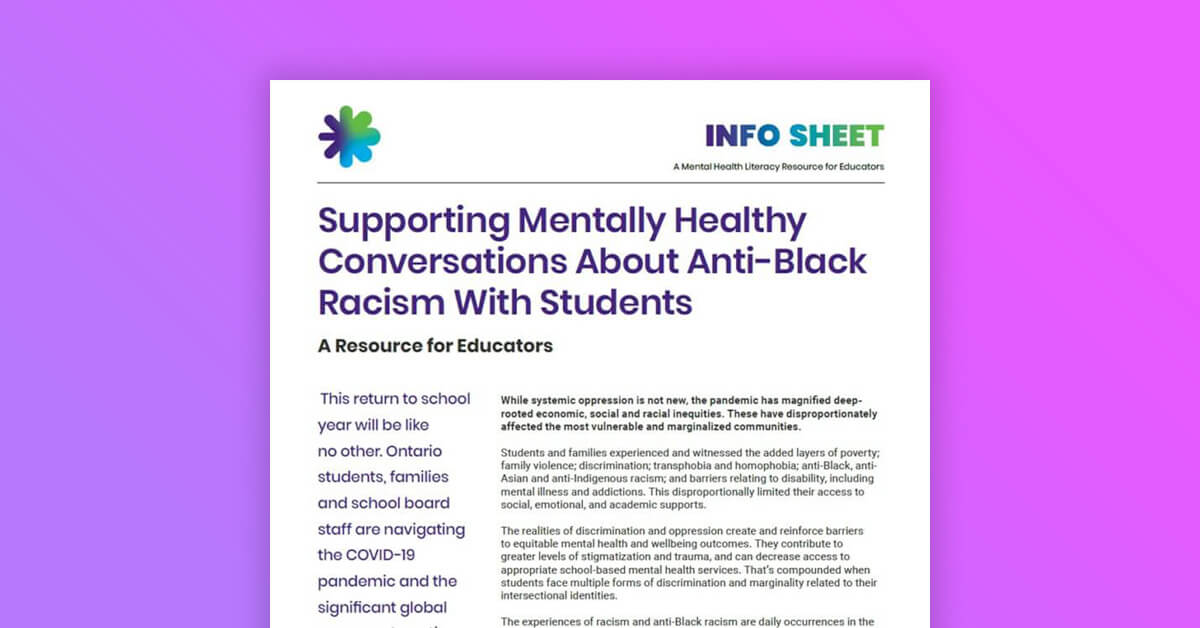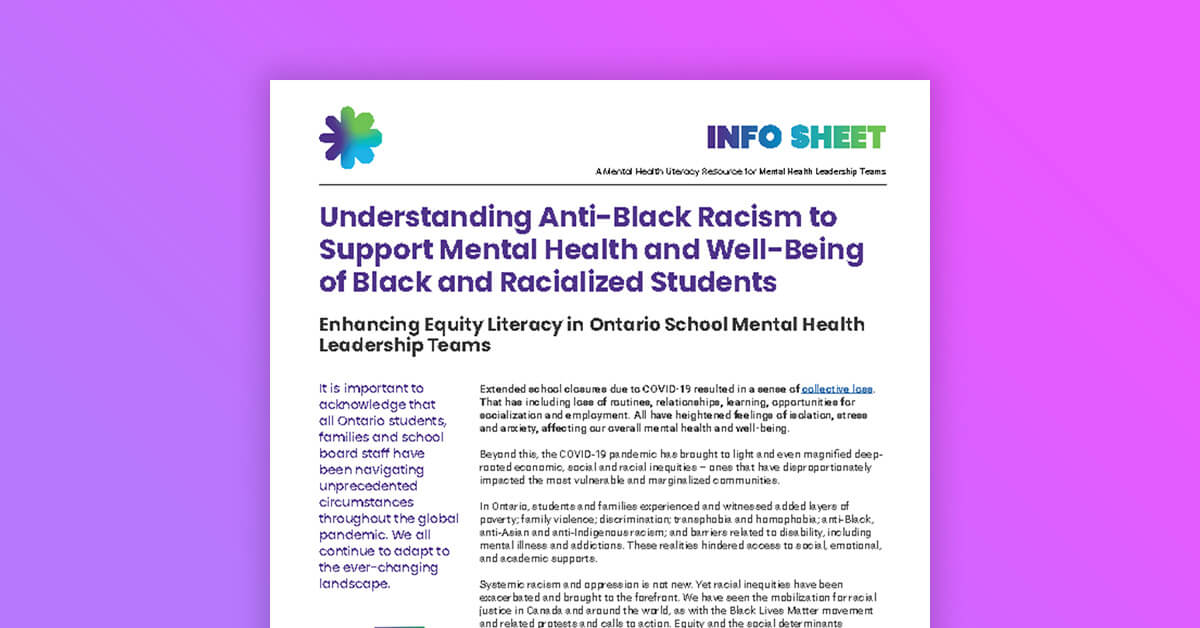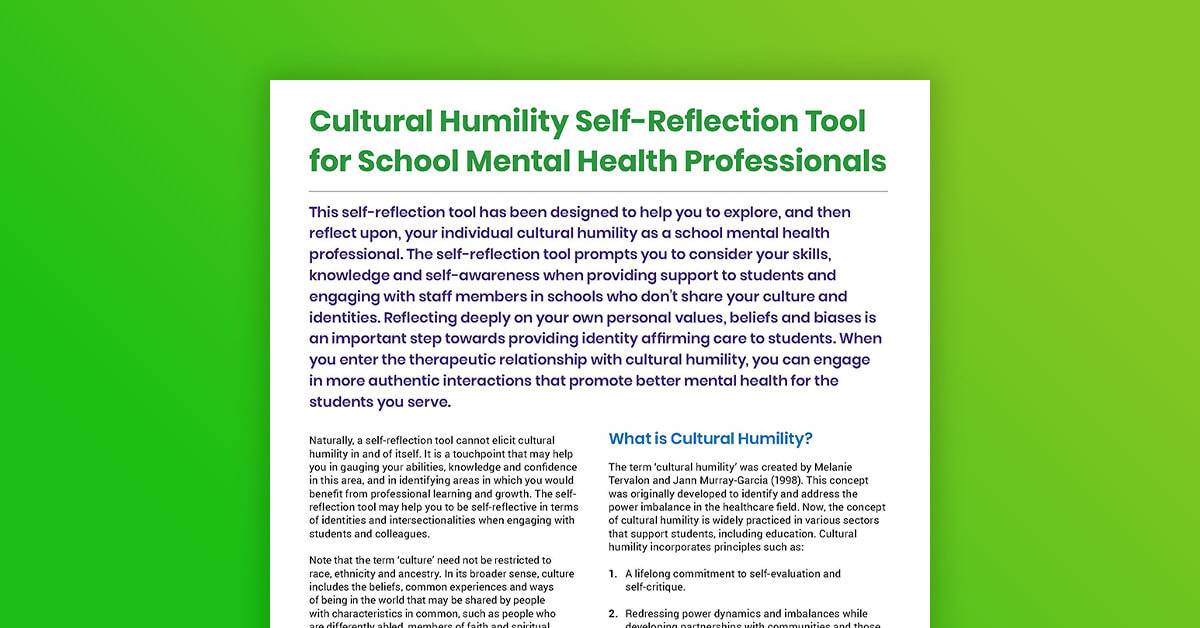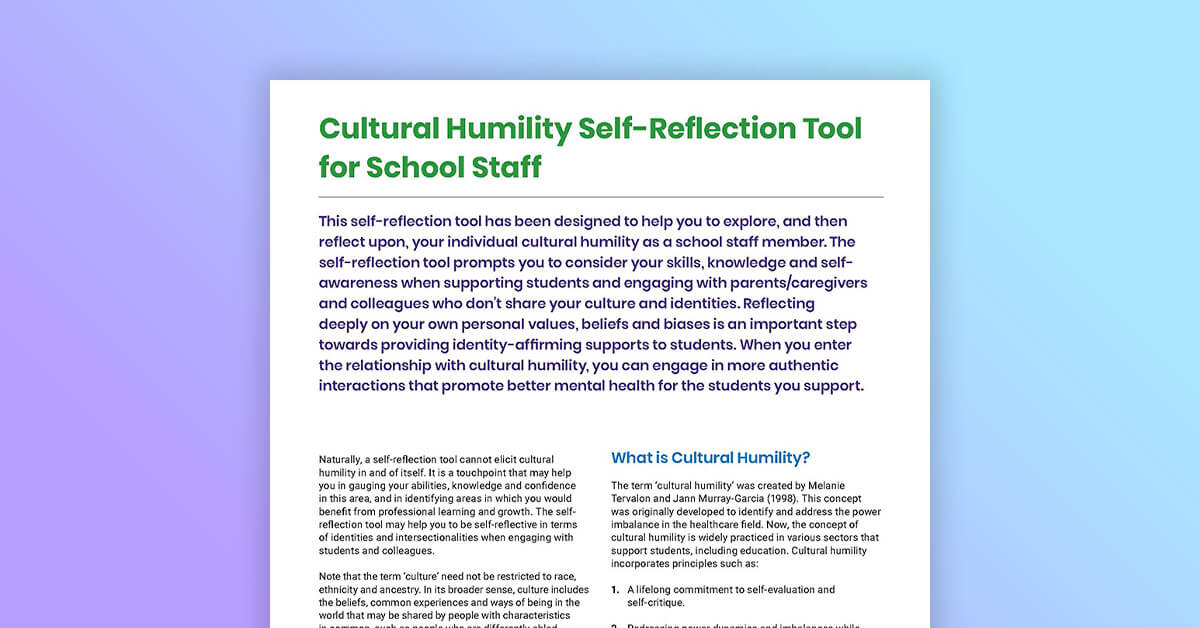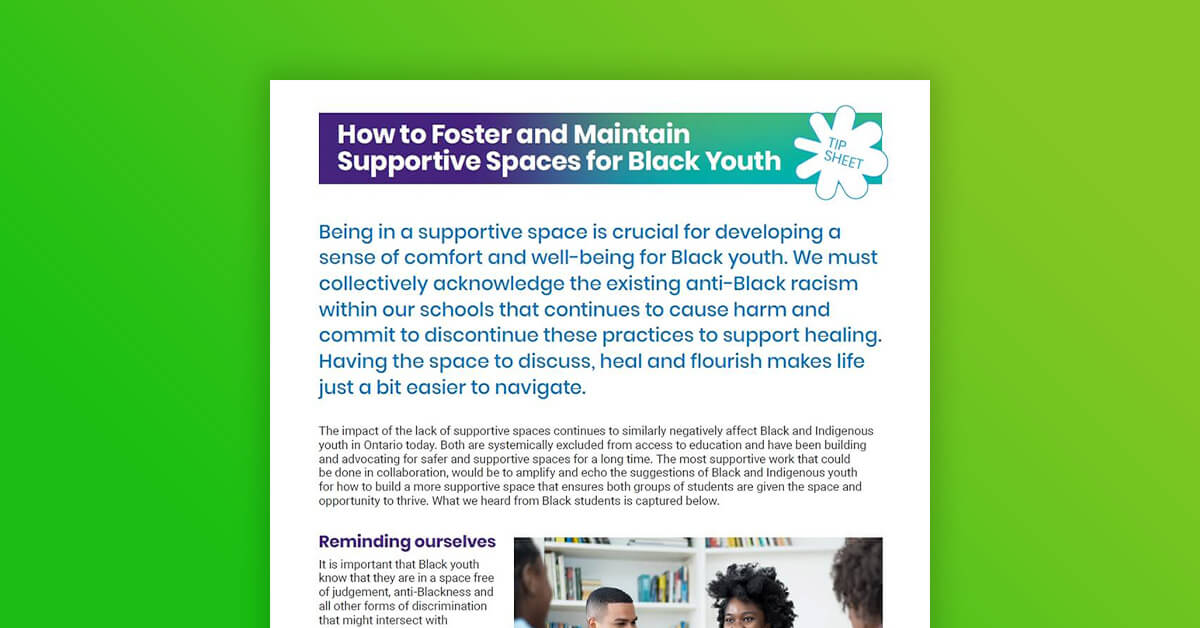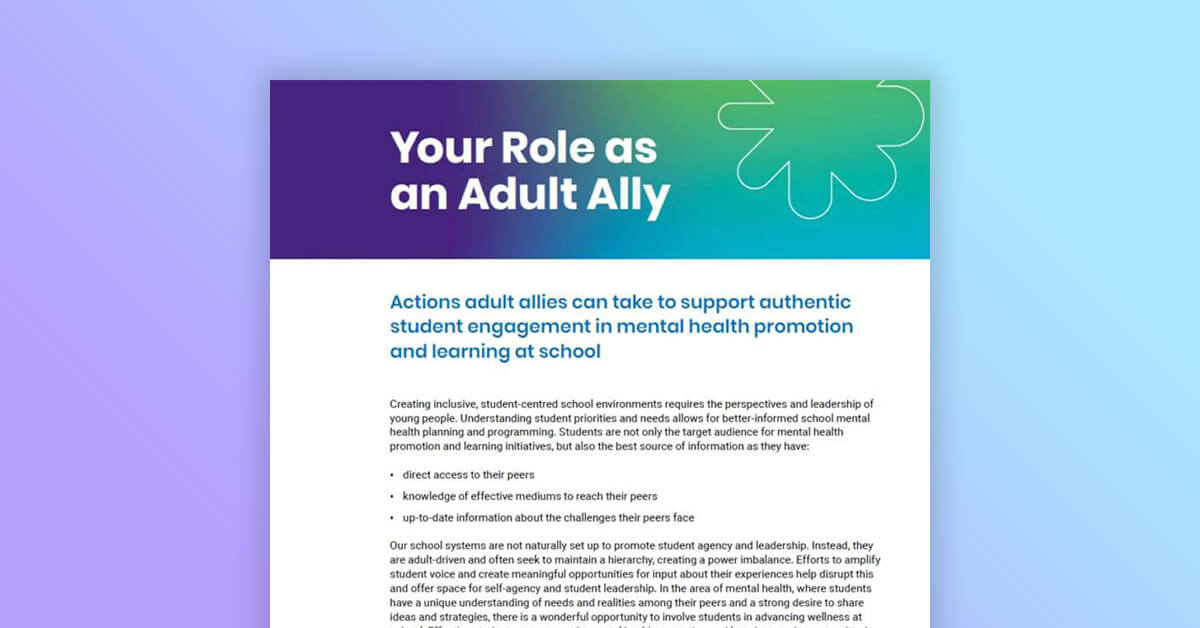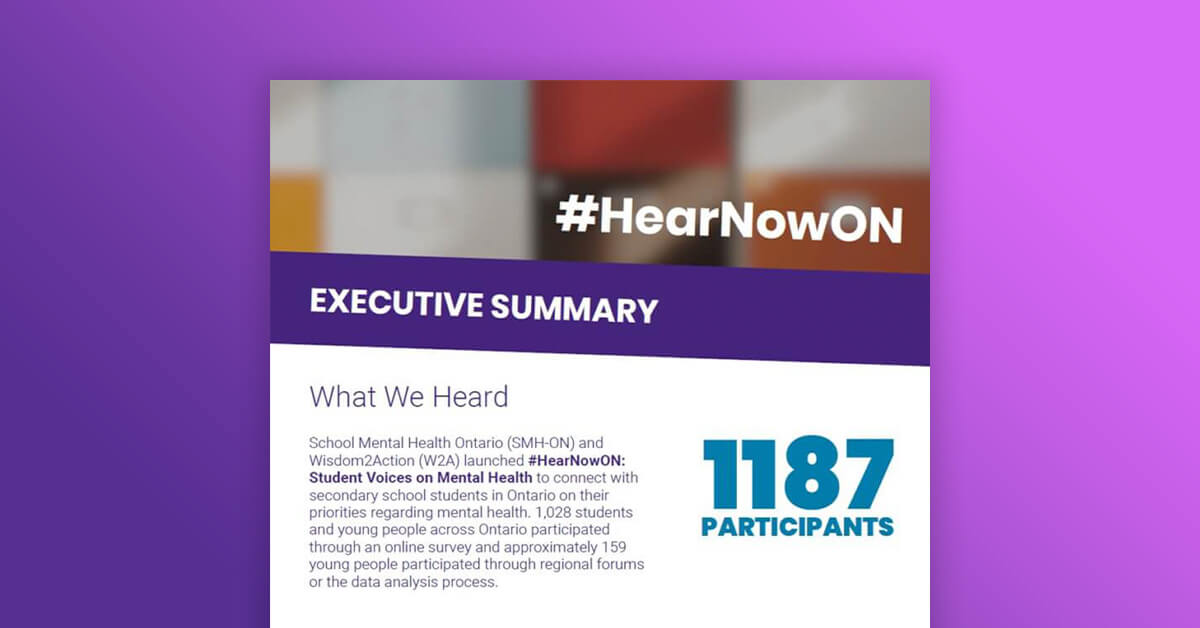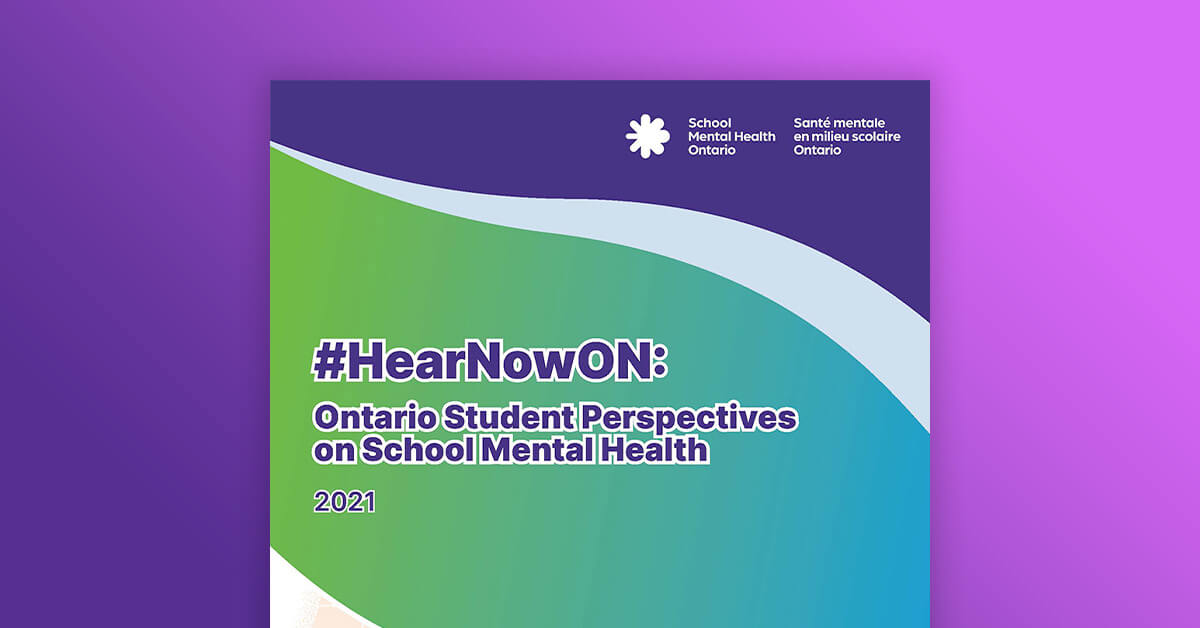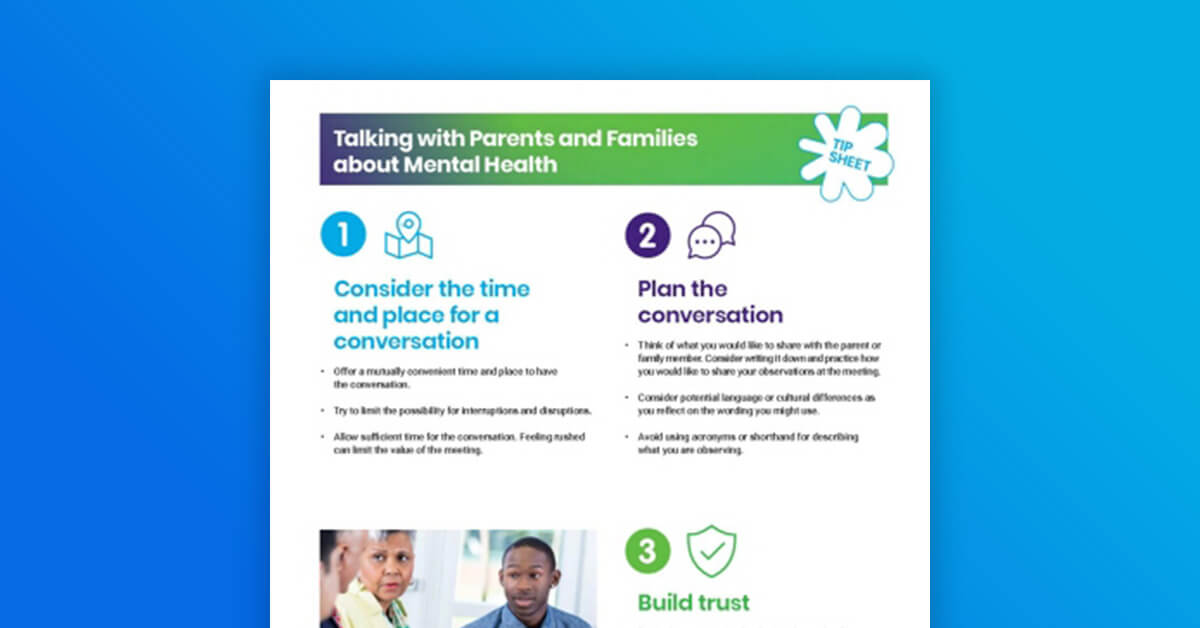Identity-affirming school mental health: a frame for reflection and action
School mental health done well is identity affirming.
Video opens with text on screen:
At the centre of Ontario’s school mental health strategy is every student and their unique strengths, identities, needs and natural supports.
A graphic of the strategy unfolds:
The graphic starts with a circle. The very centre says every student.
A ring around the centre circle says commitments to Truth and Reconciliation and equity.
The next ring out has the words dismantle, engage, amplify and respond.
The next ring is broken into equal sections for the multi-tiered system of support. There are five sections for Tier 1, two sections for Tier 2 and one section for Tier 3.
Tier one includes:
Parent, caregiver, and community connections and support
System, school, classroom mental health leadership
Strength-based mental health promotion
Mental health literacy and stigma reduction
Student leadership, participation and agency
Tier 2 includes:
Early identification and student support
Prevention and early intervention
Tier 3 includes:
Intensive supports and service pathways
The outside frame says mentally healthy learning environments, teaching and learning, student engagement and allyship, partnerships and services.
The centre of the circle that says every student then expands to take over the screen and is replaced by a series of diverse student photos, each appearing one at a time.
The circle then changes back to the words every student and shrinks. Text appears:
Differentiated and identity-affirming supports wrap around every student across the tiers of intervention.
But how? The Identity-Affirming School Mental Health Frame offers guidance related to places for reflection and action.
The screen changes to show a graphic with the title The Identity-Affirming School Mental Health Frame.
The graphic is a circle or wheel. The very centre says every student.
A ring around the centre circle says commitments to Truth and Reconciliation, and equity.
The next ring out has the words dismantle, engage, amplify and respond. Each section opens one at a time starting on the bottom left:
Respond with differentiated and Identity affirming mental health supports
Then the top right:
Engage and partner with students, parents/caregivers and community with cultural humility.
Then the bottom right:
Amplify diverse student, parent/caregiver and community perspectives by decentring whiteness
Then the top left:
Dismantle and remove oppression and racism with anti-oppressive and anti-racist policies and practices.
The graphic disappears and words appear:
School mental health done well is grounded in Truth and Reconciliation
School mental health done well is grounded in equity
Those words transition to say:
School mental health done well is identity affirming.
The video ends as the screen becomes a purple, blue and green gradient and the School Mental Health Ontario logo appears in white in the very centre.
Background
Schools are well placed to work alongside the community and healthcare settings to support the unique mental health needs of every student in Ontario. The system of care varies across the province based on local needs, strengths and available resources. In Ontario, the COVID-19 pandemic has magnified existing disparities and disproportionalities related to mental health supports inside and outside of school. In response, the multi-tiered system of mental health support in schools needs to be applied in an agile manner, centring the needs of those most marginalized and oppressed historically and presently, especially Indigenous and Black students.
Centring Black and Indigenous Students
Indigenous and Black peoples have endured deliberate, comprehensive, and prolonged assaults on their human rights in Canada. The legacy of colonization, slavery, residential schools have and continue to systemically oppress and marginalize. When we centre Black and Indigenous voices and perspectives in our work to advance well-being, we are taking collective action for a better future for every student. Their experiences are unique but inherently woven into the struggles and inequities experienced by other marginalized identities. By explicitly supporting Black and Indigenous students’ mental health and well-being, we will inevitably gain knowledge and understanding to inform our actions to support other marginalized identities.
School mental health done well recognizes and affirms the identity of every student. Identity and mental health are inextricably linked. Who you are impacts how you feel. When your identity is affirmed, reflected and celebrated, and you feel a sense of hope, purpose, belonging and meaning, you’re more likely to feel a strong sense of positive mental health, well-being and connection. If your identity is ignored, excluded, or misunderstood, or if you experience racism or oppression, you can suffer emotionally and must work much harder than others to gain a sense of well-being.
school mental health:
- places the student, with their unique and intersecting identities, at the centre of mental health support at school.
- recognizes and builds upon individual, cultural and community strengths.
- adapts or accentuates mental health programming and services to meet each student’s identified needs, in a respectful, humble, and collaborative manner.
- emphasizes the importance of every staff member (no matter what role they have in their school, community or board), critically reflecting on their practice, exploring and understanding their identities and how who they are impacts the work they do and the relationships they have.
- ensures that service delivery across the tiers of intervention (mental health promotion, prevention, early intervention) is accessible, inclusive, culturally relevant and responsive.
- is offered in partnership with communities and organizations with unique expertise in equity, reconciliation, and mental wellness, amplifying the good work, and ways of knowing and being of others.
This work is a critical part of ensuring equity of access and outcomes in mental health for those who experience disproportionalities and disparities because of factors related to the wider social determinants of health (e.g., race, ability, sexual orientation, income, etc.). Student’s identities impacted by historic and current unequal treatment, systemic barriers, and colonial legacies disproportionally experience poor mental health and well-being; and require fair (equitable) and intentional anti-oppressive and approaches to supporting mental health.
To address oppression and marginalization, different and varied approaches (differentiated approaches) to supporting student mental health and well-being are necessary for every student, and specifically for those whose identities have been marginalized, so that every student can experience positive mental health and well-being.
Mental Health Leadership Teams are working hard, alongside equity and culture leads, students, parents/caregivers and community partners to provide identity-affirming school mental health supports and services. Part of this involves a process of reflection, recognizing that the legacy of colonization, enslavement, institutionalized racism, discrimination, and the resulting trauma has produced disparities in educational, mental health, and life outcomes for many, especially Black and Indigenous students.
Identity-affirming school mental health approaches and supports are responsive to individual student needs and affirm intersecting and developing identities. This approach contributes to, and benefits from the wider efforts in school boards and schools to address oppression and marginalization, and to work towards reconciliation, equity and justice, especially for those historically and presently oppressed. Moving from current practice to an embedded and integrated identity-affirming school mental health approach takes time, reflection, and planful action.
The goal of the Identity-Affirming School Mental Health Frame is to help guide Mental Health Leadership Teams as you thoughtfully reflect and plan resources and supports in your respective communities that meet the unique needs of every student you serve.
Explicit commitments to truth and reconciliation
The path to identity-affirming school mental health begins with explicit individual and collective commitments to Truth and Reconciliation, and equity. Truth refers to acknowledging and uncovering the historical truths, injustices, and systemic abuses that have been inflicted upon Indigenous peoples. Reconciliation amplifies and affirms the inherent sovereign rights of Indigenous peoples to the reclamation of identity, language, culture, and land. Equity commitments are vital in addressing the unfair distribution of access and opportunities resulting in disparities that are based on identity-markers like race, gender identity and expression, sexual orientation, religion, ethnicity, culture, immigration status, first language, ability, etc. We refer to these groups as equity-denied and deserving. School mental health that is grounded in explicit commitments to Truth and Reconciliation, and equity works to ensure that every student has direct access to the supports and resources to address their unique needs.
Equity and reconciliation: Separate but alongside
It is important to understand that the historical and ongoing colonialism faced by Indigenous peoples is unique and separate from the oppression faced by other equity-denied and deserving groups. Although the journeys to and from may be different, there are commonalities in the inequities faced, and efforts towards reconciliation can inform the work of equity in school mental health. This work will be done well when equity and reconciliation are united efforts, forged forward separately but alongside towards identity-affirming school mental health for every student.
To understand reconciliation and equity as separate but alongside journeys, it is essential to recognize the distinction between Indigenous communities, which include diverse and sovereign-seeking nations, and equity-denied and deserving communities. Indigenous peoples’ experiences of colonization, dispossession (historical and ongoing processes of taking lands cared for by Indigenous peoples, resources, and autonomy by external forces, resulting in the loss of traditional territories and ways of life), and ongoing struggles for self-determination are distinct from the challenges faced by equity-denied and deserving groups. Therefore, the journey to equity for equity-denied and deserving communities is separate from Indigenous peoples’ reclamation journey of land, culture, languages, and self-determination.
Recognizing this distinction stresses the importance of implementing practices that honour and respect Indigenous rights, cultures, languages, and sovereignties, while also addressing the unique needs and experiences of equity-denied and deserving communities. By fostering an inclusive and identity-affirming approach to student mental health, schools can create a supportive environment that celebrates diversity, promotes self-determination, and supports the well-being of every student.
Moving from current practice to an embedded and integrated identity-affirming school mental health approach takes time, reflection, and planful action. The Identity-Affirming School Mental Health Frame offers four domains to frame the work as you thoughtfully reflect and plan approaches and supports to meet the unique needs of every student you serve. As is also reflected in the School Mental Health Ontario Strategy for 2022-2025, all supports and services wrap around Every Student, depicted at the centre of the graphic. The domains aren’t linear—each can and should be addressed simultaneously.
Identity-Affirming School Mental Health Frame
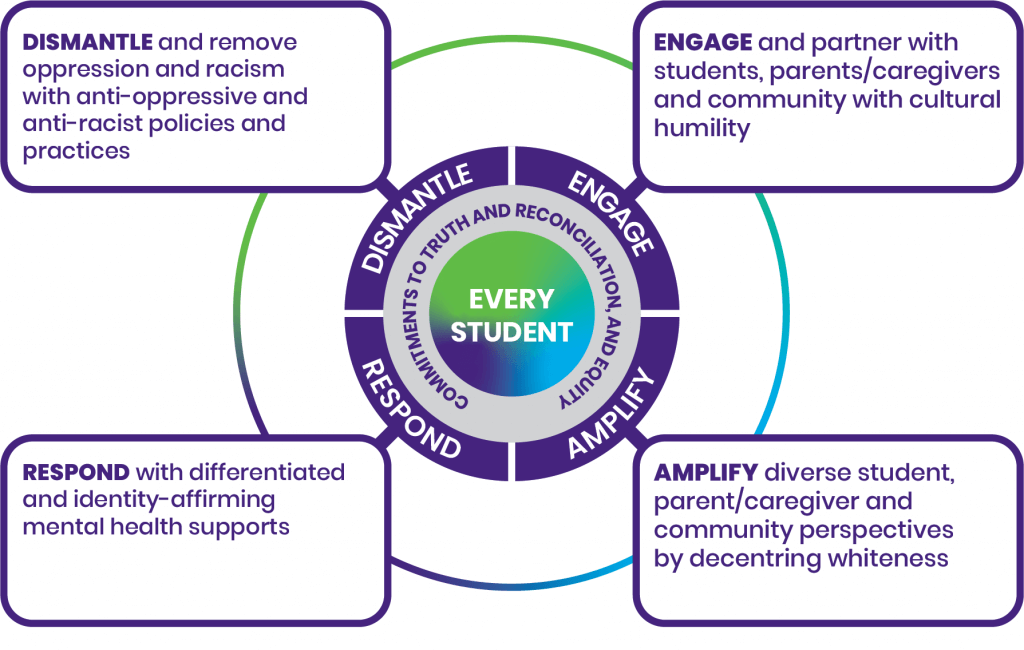
The very centre says every student. A ring around the centre circle says commitments to Truth and Reconciliation, and equity.
The next ring out has the words dismantle, engage, amplify and respond. Each word expands out to a box with a definition:
Dismantle and remove oppression and racism with anti-oppressive and anti-racist policies and practices
Engage and partner with students, parents/caregivers and community with cultural humility
Respond with differentiated and identity-affirming mental health supports
Amplify diverse student, parent/caregiver and community perspectives by decentring whiteness
Dismantle and remove oppression and racism with anti-oppressive and anti-racist policies and practices
Dismantling systems that perpetuate racism and oppression begins with naming and acknowledging white supremist, colonial, heteronormative ideology that is part of society, and our schools. Much of how we work and learn in schools has been constructed using white cisgender ableist norms as default. This has marginalized many students and families who are underrepresented in decision-making and daily practices, which has significant impacts on sense of identity, belonging, and mental health.
In this work, it is important to recognize all forms of oppressed identities, while acknowledging the distinct and complex history of anti-Black and anti-Indigenous racism that continues to harm Black and Indigenous students. Boards and schools are reflecting deeply about this and considering and acting upon ways to dismantle structures and processes that are harmful and rebuild just ones.
In addition, board and school staff are engaging in learning and unlearning, so that they can be sure to adopt an anti-oppressive, anti-racist stance in their daily practice. These practices aim at correcting structural and personal power imbalances, where unearned privilege and power are created and protected for some while at the same time creating and maintaining inequitable conditions for others. When schools and boards are evaluating their policies, protocols, and practices to align with anti-oppressive and anti-racist values, they must follow a process of identifying the inequities, assessing how the system and structures allowed the inequity to exist, eliminating the inequity and reconfiguring with equity commitments, then redistribute access and opportunities.
In addition to supporting individual and collective learning, Mental Health Leadership Teams can challenge one another with reflective questioning. This learning, unlearning, and questioning work is critical for setting the conditions for effective practices across the multi-tiered system of support in school mental health.
Resources:
Engage and partner with students, parents/caregivers and community with cultural humility
Students want to be part of the conversation about school mental health, and their perspectives are imperative to advance differentiated identity-affirming school mental health practices and supports.
One of the key findings from #HearNowON was a strong interest amongst participants in ensuring that the intersection of identity, culture and mental health was recognized and addressed. It’s important that we offer students ongoing platforms for voice and leadership in this area, with an understanding of the importance of representation and engaging diverse student voices. Many school boards have developed student mental health leadership groups that can be supported in this work by adult allies.
Families, caregivers and communities are often children’s first teachers, and are where young people begin to establish their identity, getting to know their strengths, needs and more. Wrapping around every student is a community that may be defined in many different ways – wider family, culture, faith, geography, language, gender, sexual orientation, etc.
Community groups and organizations have developed ways of mutual support and known practice that serve one another well. Schools can provide identity-affirming approaches to supporting mental health best when they work with families/caregivers and community as equal partners in designing and delivering programming across the multi-tiered system of support. Meaningful collaboration and engagement with students, parents/caregivers and community, demand cultural humility, partnership, and a deliberate commitment to centring the voices, perspectives, and expertise of historically marginalized individuals. An essential component of meaningful engagement is exercising cultural humility. Cultural humility requires acknowledging the limits of our own knowledge and being open to learning from students, parents/caregivers, and the wider community while recognizing our own identities, and experiences of power and privilege. By embracing cultural humility, we engage in ongoing self-reflection, critically examining our beliefs, values, and biases to understand their impact on our interactions and decision-making processes.
Resources:
Amplify diverse student, parent/caregiver and community perspectives by decentring whiteness
Young people, parents/caregivers, and communities have an important voice and many ideas and practices on how to support their mental health and well-being. Creating space, and sharing power allows for deep collaboration and for important perspectives to rise. For example, when we support at school, we can further amplify voices of those who have been oppressed and may not have felt confident sharing their views in the past.
When we listen to parent/caregiver concerns, and honour their expertise around their children’s well-being, we can work together to find better ways forward and are inviting new relationships that facilitate healthy home-school communication more generally. Similarly, when we take time to listen and learn about practices in community spaces that help to build self-love, culture, belonging, and relationship, we can work together with our partners to bring these ideas to the school setting, amplifying their good work (being careful not to appropriate the practices, but instead offering a way for cultural / community practitioners to share their leadership). Creating space facilitates agency, wellness, and hope.
Recognizing ideological perspectives and colonial practices that negatively impact students’ right to agency over their mental health and well-being is the first step to sustaining the creation of accessible, responsive, differentiated and identity-affirming approaches and practices. In school mental health, this process begins with acknowledging and and the colonial legacies that are embedded in school mental health practice. At the centre of almost everything we do currently in schools and for student mental health is – white perspectives rooted in colonialism and eurocentrism. Whiteness is given unequal power and influence and other ways of knowing and being are marginalized and excluded. For resources and supports to be relevant and responsive we must actively decentre whiteness, by shifting the power dynamic of what is normally at the margins to the centre. To redistribute power and space to intentionally favour and prioritize the diverse ways of knowing, being, and understanding and to address mental health and well-being from Black, Indigenous, and marginalized peoples’ perspectives. Decentring whiteness is an act of liberation and a way to centre the lives, voices, and engagement of those systematically excluded in the current education system’s policies and practices. This amplification of diversity in schools is essential to identity-affirming practices.
Decentring whiteness from the power of the centre does not happen without some thoughtful planning of what will replace the centre, as whiteness is moved to the margins (not eliminated) to intentionally prioritize the needs and access of students who historically have been and presently continue to be, denied access and opportunity. Black and Indigenous peoples have endured deliberate, comprehensive, and prolonged assaults on their human rights in Canada (e.g. because of colonization, slavery, residential schools etc.) and have been and continue to be systemically oppressed. By centring Black, Indigenous and marginalized voices and perspectives in our work to advance well-being, we are taking collective action for a better future for every student. Their experiences are unique but inherently woven into the struggles and inequities experienced by other marginalized identities. By explicitly supporting Black and Indigenous students’ mental health and well-being, we will inevitably gain knowledge and understanding to inform our actions to support other marginalized identities. And when we challenge our assumptions and reflect on what we think we know from past learning, it not only makes us better people/professionals, it also opens up possibilities for including other ways of knowing that may better serve historically and presently marginalized students.
Resources:
Respond with differentiated and identity-affirming mental health supports
Most school mental health approaches and supports used in North America were developed and tested from western, white perspectives. Few have been created with and informed by the various lived experiences of students and their intersectional and developing identities. For students to have the ability and resources to care for their mental health, they need access to school mental health services across the multi-tiered system of support that are affirming, supportive, meaningful, and reflect their realities. School Mental Health Ontario is actively working with community/cultural partners to add to the suite of protocols and programming across the tiers of intervention and is also providing tools to support use of evidence-informed protocols in an identity-affirming manner and differentiated ways. Identity-affirming and approaches and practices enhance the relevance, accessibility, and effectiveness of mental health care, ultimately promoting better mental health outcomes for every student.
Resources:
The Identity-Affirming School Mental Health Frame has been developed with guidance from a variety of key stakeholders who work in the publicly funded education system in Ontario. Students, educators and school mental health professionals with varying levels of responsibility and perspectives from across Ontario collaborated and offered guidance to help Ontario school boards reflect and take action toward identity-affirming school mental health. School Mental Health Ontario combined guidance from the field with information from our student engagements, board scan data, and other regional mental health leadership consultations and engagements to build the frame.
The Identity-Affirming School Mental Health Frame is also theoretically grounded by three frameworks. As the centre of School Mental Health Ontario’s strategic plan, the frame is supported by Bronfenbrenner’s Ecological Systems Theory (Bronfenbrenner, 1979). This theory considers the interrelationship among people and structures across multiple levels in school mental health. In addition, implementation science (Eccles and Mittman, 2006) provides a reference point for the Identity-Affirming School Mental Health Frame’s focus on promoting and supporting systematic uptake in the school board setting. Lastly, and most importantly, the Identity-Affirming School Mental Health Frame is grounded in anti- oppressive theory (Dominelli, 1996), with a focus on eliminating all forms of oppression that are anchored in structural inequities within school mental health.
While many inputs, engagements, conversations, and meetings helped to form the basis for the Identity-affirming School Mental Health Frame, we want to specifically acknowledge the consultation and input from the planning and consultation group members listed below for sharing their time, perspective and guidance in the spirit of collaboration with members of the SMH-ON team.
Carley Kiiskila (Conseil scolaire de district catholique des Aurores boréales)
Cassandra Nyimbili (Niagara Catholic DSB)
Showbiga Buvanendran (Toronto DSB)
Yousra Lakhani(Toronto DSB)
Allison Ebanks (Durham DSB)
Ananya Roy (Toronto DSB)
Eleanor McIntosh (Durham DSB)
Geer Harvey (Upper Grand DSB)
Jane Lower (Keewatin-Patricia DSB)
Laura Conboy (Limestone DSB)
Liana Thompson (Grand Erie DSB)
Lisa Jeffers (Durham Catholic DSB)
Mahin Aman (Peel DSB)
Patricia Marra-Stapleton (York Region DSB)
Rasha Balche (Halton DSB)
Sue Devlin (Kenora Catholic DSB)
Yasmin Smith (Waterloo Catholic DSB)
Glossary
An affinity group is an intentionally designated space where everyone in that group shares a particular identity. This identity can be based on race, gender, sexual orientation, language, nationality, physical/mental ability, socio-economic class, family structure, religion, etc. Affinity groups can be a place for underrepresented students or staff to come together to feel less isolated and more connected. Student or staff affinity groups allow participants who share identities—usually marginalized identities—to gather and talk in a supportive space about issues related to that identity and transfer that discussion into action that makes for a more equitable experience at school.
Intentionally centring students by making meaningful connections to students’ identity and lived experience, that addresses and helps remove (systemic or any) barriers to student well-being. Cultural responsivity in practice is about being aware of students’ identity and lived experiences and how your identity intersects and interacts with theirs, as you work together towards building meaningful connections in your shared experiences at school.
Decentring whiteness is a process of moving whiteness from the centre of society while at the same time centring diverse perspectives. This intentional action requires naming theways in which whiteness is centred by continuously interrogating and challenging existing structures, processes, and practices, while using our power, influence, and privilege to amplify diverse ways of knowing and being. Without intentional action to centre historically and presently marginalized perspectives, whiteness will continue to occupy the centre. Centring the diversity of ways of knowing and being will enrich our learning environments and school mental health practices to help affirm every student’s identities – especially those who have been historically, and are currently, marginalized and oppressed.
Differentiated school mental health approaches and practices adapt support and services to every student’s unique needs, strengths, circumstances, preferences and experiences while validating and respecting their identities and background. Differentiation reinforces that one size does not fit all.
Identity-affirming school mental health affirms and centres an individual’s sense of self and identity, considering the impact of identity on mental health and well-being.
This involves:
• Building positive connections, by acknowledging, validating, and respecting, a student’s unique identity (including but not limited to race, ethnicity, gender, sexual orientation, cultural background, socioeconomic status, and abilities)
and
• Prioritizing cultural knowledge and practices that are responsive to every student.
A term coined by Kimberlé Williams Crenshaw to describe the interactive effects of various forms of discrimination, including the specific kinds of challenges experienced by people with overlapping identities. For example, the experience, barriers and oppression that a Black-nonbinary student may face in school differs from that of cisgender Black student or white-nonbinary student because of the intertwining effects of various systems of oppression (such as racism, ableism, sexism, ageism and others). An intersectional lens allows us to examine how students’ different social identities (race, ability, gender, age, class, and more) are interconnected, and how different contexts create privilege and/or oppression.
COVID-19 amplifies the complexity of disability and race – Brighter World (mcmaster.ca)
Racial literacy refers having the knowledge, skills, awareness and dispositions to talk about race and racism. How do we think about race? How do we talk about race? How do we teach issues of race? Racial literacy also requires that we engage in serious self- reflection about our feelings on race, diversity, and opportunity for Black, Indigenous and racialized students.
Whiteness has been socially constructed to unfairly confer unequal power and influence to white perspectives. White perspectives are historically rooted in colonialism and Eurocentrism. Placing white perspectives at the centre of society resulted in marginalizing other ways of knowing and being. At the centre, the power and influence of whiteness pervades all aspects of society and defines the standard by which everything else is measured and practiced, including school mental health. If whiteness continues to go unnamed and unchallenged as the default, the diversity of other ways of knowing and being continues to be marginalized.


